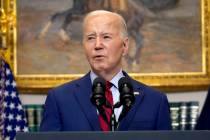Advocates seek more funds for Nevada’s English learner program

It’s early one Thursday morning at Jay W. Jeffers Elementary School in Las Vegas, and Lisa Cabrera-Terry’s voice is spilling from the first-grade classroom where she’s reading about an illiterate grandma who surprises her family by learning to read.
Cabrera-Terry takes a fat marker to a sheet of poster paper and adds to a wheel-shaped diagram of words that describe feelings.
“If your face beams, you’re sooooo happy,” she said. “Why are they so happy about grandma reading?”
To the untrained eye, the lesson is nothing unusual. But Cabrera-Terry is at a school where 83 percent of incoming kindergartners don’t speak English, where you take every picture book page slow and where you tell students exactly what “astonished” means and explicitly that it’s a word to describe a feeling.
It’s a classroom like so many others in Nevada, which is home to the highest density of English language learners in the nation, at 31 percent. What’s taking place in those classrooms — and what is not — has parents worried, some lawmakers concerned and a civil rights group investigating.
If the percentages hold, fewer than one in three of these fresh-faced first-graders will wear a cap and gown. Just 29 percent of English language learners, called ELL students, ever graduate from Nevada high schools, according to federal data.
While there’s ongoing debate about the most effective ways to teach the tens of thousands of students who fall in that category, the main focus of the debate over the state’s high ELL failure rate comes down to money.
“What has always held us back as Nevadans is this ideology that we can’t expand the revenue pie,” said Sylvia Lazos, director of the Immigration Clinic at Boyd School of Law at the University of Nevada, Las Vegas. “The real question is: What does it take to give these kids a chance to succeed?”
Lazos said she feared the consequences of large swaths of Nevadans failing to graduate and unable to weather a changing economy. She said it may take a lawsuit to convince the community to think differently.
The average state funding rate across the country for ELL students is 1.39, which means districts spend 39 percent more on those students. For example, if a district spends $10,000 per student, it will add $3,900 for every ELL student it has.
In Clark County, the state’s largest district and the fifth-largest in the nation with 341 schools and nearly 312,000 students, the district allots $119 per ELL student per year, according the Lincy Institute at UNLV.
Republican Gov. Brian Sandoval this spring proposed applying $50 million in state funding to these students over the next two years. It’s a historic move in Nevada, one of eight states that don’t provide extra state money for English learners.
That would translate to $358 in new funding per ELL student per year. But it’s not nearly what some think is needed.
State Senate Majority Leader Mo Denis, D-Las Vegas, is pushing for $140 million for ELL programs. But with less than two weeks left in the legislative session, plans to increase taxes and add to Sandoval’s recommendations are all but dead.
The question of how much money would be enough remains understudied, and various reports so far haven’t focused on the state’s burgeoning English learner population, according to the Lincy Institute.
A 2006 study — commissioned by the Nevada Legislature and based on data that are now a decade old — contends Nevada should be spending five to eight times what the governor proposes. One estimate put the number at $132 million per year; another put it at $206 million per year.
This debate has played out amid larger political and demographic shifts in the state.
Clark County’s population jumped 42 percent between 2000 and 2010, driven by a housing and business boom. Immigrants poured in for a share of the abundant jobs, and the number of children who spoke a language other than English at home jumped 43 percent in Nevada during that decade.
When the economy took a nosedive, many residents expected immigrants to return home in droves, Lazos said. That never happened, in part because stringent border security would have made it nearly impossible for those who chose to leave to ever come back.
As the economy recovers and a federal immigration overhaul promises a pathway to citizenship for those in the country illegally, Nevada must accept that its young, heavily immigrant population will stay, said Sonya Horsford, the Lincy Institute scholar who led a study on the state’s ELL students.
“This is our population. This is America,” Horsford said. “We should start looking at it as an opportunity.”
While other states have robust funding for ELL students, that doesn’t necessarily mean they’re translating dollars into success. Lawsuits have been filed in 44 states over concerns that ELL students weren’t getting an equal education, according to the Lincy report.
Nevada may soon be added to the list.
Earlier this month, two lawyers from the Mexican American Legal Defense and Educational Fund came to Las Vegas to hold fact-finding meetings in Spanish, asking parents whether they’ve had run-ins with teachers ill-equipped to handle students learning English.
No lawsuit is imminent, Lazos said.
Often, the struggles of ELL students are hidden.
Students quickly pick up conversational English on the playground, but the gaps in their comprehension show up on standardized tests, which find that 98 percent of Nevada’s eighth-grade ELL students aren’t proficient in reading, compared with 71 percent of their non-ELL peers.
“They can appear to hang with the rest of the students,” said Tracy Spies, an assistant professor of Teaching English to Speakers of Other Languages (TESOL) at UNLV. “But paper-pencil tasks require a different level of instruction.”
Those struggles can snowball until students give up on school altogether.
State officials believe they can get at the problem by distributing the $50 million state funding into grants focused on five areas, including developing pre-K programs that target 3- and 4-year-old ELL students, acquiring tools to assess ELL students’ reading levels, buying software that improves language skills, and developing before and after school or summer programs for ELL students.
About 80 percent of Clark County’s ELL students are born in the United States, suggesting that struggles with English have more to do with linguistic isolation than immigrant status. Spending time outside the home through pre-K or summer programs could help break the isolation.
The fifth goal is teaching teachers to get through to their ELL students, which could mean helping more of them earn a TESOL certification, or adding to a team of 14 literacy coaches in Clark County .
“We all need to teach teachers to be language teachers,” said Lucy Keaton, Clark County School District’s first-ever assistant superintendent of ELL. “We all own these children.”


















